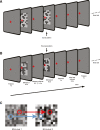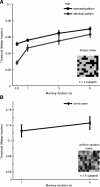The influence of spatial pattern on visual short-term memory for contrast
- PMID: 24715467
- PMCID: PMC4212202
- DOI: 10.3758/s13414-014-0671-x
The influence of spatial pattern on visual short-term memory for contrast
Abstract
Several psychophysical studies of visual short-term memory (VSTM) have shown high-fidelity storage capacity for many properties of visual stimuli. On judgments of the spatial frequency of gratings, for example, discrimination performance does not decrease significantly, even for memory intervals of up to 30 s. For other properties, such as stimulus orientation and contrast, however, such "perfect storage" behavior is not found, although the reasons for this difference remain unresolved. Here, we report two experiments in which we investigated the nature of the representation of stimulus contrast in VSTM using spatially complex, two-dimensional random-noise stimuli. We addressed whether information about contrast per se is retained during the memory interval by using a test stimulus with the same spatial structure but either the same or the opposite local contrast polarity, with respect to the comparison (i.e., remembered) stimulus. We found that discrimination thresholds got steadily worse with increasing duration of the memory interval. Furthermore, performance was better when the test and comparison stimuli had the same local contrast polarity than when they were contrast-reversed. Finally, when a noise mask was introduced during the memory interval, its disruptive effect was maximal when the spatial configuration of its constituent elements was uncorrelated with those of the comparison and test stimuli. These results suggest that VSTM for contrast is closely tied to the spatial configuration of stimuli and is not transformed into a more abstract representation.
Figures




Similar articles
-
Stimulus-specific mechanisms of visual short-term memory.Vision Res. 1991;31(7-8):1213-9. doi: 10.1016/0042-6989(91)90046-8. Vision Res. 1991. PMID: 1891813
-
Task-dependent transfer of perceptual to memory representations during delayed spatial frequency discrimination.Vision Res. 2002 Jun;42(14):1759-69. doi: 10.1016/s0042-6989(02)00111-6. Vision Res. 2002. PMID: 12127108
-
Visual short-term memory for global motion revealed by directional and speed-tuned masking.Neuropsychologia. 2013 Apr;51(5):809-17. doi: 10.1016/j.neuropsychologia.2013.02.010. Epub 2013 Feb 27. Neuropsychologia. 2013. PMID: 23454262 Clinical Trial.
-
Masking of spatial frequency in visual memory depends on distal, not retinal, frequency.Vision Res. 1996 Jan;36(2):233-8. doi: 10.1016/0042-6989(95)00085-e. Vision Res. 1996. PMID: 8594821
-
A statistical perspective to visual masking.Vision Res. 2015 Oct;115(Pt A):23-39. doi: 10.1016/j.visres.2015.07.003. Epub 2015 Aug 24. Vision Res. 2015. PMID: 26238247
Cited by
-
Introduction to the special issue on visual working memory.Atten Percept Psychophys. 2014 Oct;76(7):1861-70. doi: 10.3758/s13414-014-0783-3. Atten Percept Psychophys. 2014. PMID: 25341647 Free PMC article.
References
-
- Albrecht DG, Hamilton DB. Striate cortex of monkey and cat: Contrast response function. Journal of Neurophysiology. 1982;48:217–237. - PubMed
-
- Blake R, Cepeda NJ, Hiris E. Memory for visual motion. Journal of Experimental Psychology: Human Perception and Performance. 1997;23:353–369. - PubMed
-
- Breitmeyer BG. Visual masking: An integrative approach. New York, NY: Oxford University Press; 1984.
Publication types
MeSH terms
LinkOut - more resources
Full Text Sources
Other Literature Sources

